
95% of researchers rate our articles as excellent or good
Learn more about the work of our research integrity team to safeguard the quality of each article we publish.
Find out more
ORIGINAL RESEARCH article
Front. Mar. Sci. , 09 April 2018
Sec. Marine Conservation and Sustainability
Volume 5 - 2018 | https://doi.org/10.3389/fmars.2018.00107
This article is part of the Research Topic Man-Induced Perturbations on Coastal Assemblages View all 4 articles
The human population of the Brazilian Amazon possesses a rich body of beliefs and practices that relate to river dolphins, which are also known as botos (Inia and Sotalia species). There is a widespread belief in their magical powers in relation to love enchantments. One form that this takes is “dolphin love charms” and these are widely in use in northern Brazil, and also in the largest southern cities. This paper considers the trade of cetacean products in the form of love charms in Brazil. Samples were obtained in the north (n = 70), northeast (n = 3) and southeast (n = 59) regions from 34 shops or municipal markets. A total of 38 of the 131 collected samples were evaluated by complete cytochrome b sequencing, revealing the use of two species: the Guiana dolphin (Sotalia guianensis) (n = 3) and the domestic pig (Sus scrofa) (n = 10) and samples containing no animal material (n = 10) were also detected. Pigs are used to fake love charm products in Rio de Janeiro. However, whereas in the southeast there is no actual use of dolphin tissues in love charms, there is a widespread use of dolphin tissue in northern Brazil, including, muscle, eyes, penis and vagina. The data confirm a regular trade of dolphin products in large cities in the north and northeast of Brazil and the need for more intense actions from governmental agencies in order to curb this illegal trade.
The human population of the Brazilian Amazon, comprising indigenous, European and African ancestries, possesses a rich body of beliefs and practices that relate to river dolphins or botos (Inia and Sotalia species). There is a widespread belief in their magical powers in relation to love enchantments. At night, people believe that river dolphins are shape-shifters and can take human form, causing harm to humans on land (Cravalho, 1999). In addition, human population along Amazon Basin Rivers believe that young, unengaged, pregnant females blame the botos for their pregnancies. For this reason, botos are considered enchanted creatures (Cravalho, 1999). This remarkable peculiarity related to Amazon dolphins leads to a widespread conviction of their magical powers in relation to love enchantment (Slater, 2001). Not surprisingly, the boto figure appears in the oral tradition of every Amazon basin community, and many of these stories have been compiled by Brazilian storytellers (Santos, 1987, 2004; Simões and Golder, 1995a,b,c; Monteiro, 2002; Val, 2007; Siqueira, 2012; Campos et al., 2013) and novelists (Souza, 1982). Therefore, the magical power and enchantment of this character displays many representations. One of the most emblematic are typically called “love charms”, meaning the use of body parts, mainly genitals, eyes and teeth, of any dolphin, for sexual purposes. Easily detected in many parts of Brazil, far beyond Amazon boundaries, the love charm trade is a common practice, but the extent of this practice and the animal species that are used for this purpose are not clear. A previous study (Best and da Silva, 1989) identified the Amazon river dolphin (Inia geoffrensis) as the most frequently traded species in two public markets, “Ver-o-Peso” in Belém, located in the state of Pará, and the Municipal Market of Manaus, in the state of Amazonas, both in northern Brazil. In this context, Siciliano (1994) raised concern over the trade of dolphin's eyes and genitals, attributed to Guiana dolphins (Sotalia guianensis), in the fishing town of Vigia, located on the eastern Pará coast. In fact, recent studies have proven either the marine origin of these dolphin samples or the fact that they are simply fake (Sholl et al., 2008). Scholl et al. indicated that, from the total of 21 love charm samples obtained in Belém, all were from S. guianensis, a salt water dwelling species. In contrast to botos, that inhabit continental waters, Guiana dolphins are found in shallow coastal waters, usually associated with mangroves and estuaries, where they feed on the most abundant schooling fish in the area (Lopes et al., 2012). Botos, on the other hand, are usually found in large river systems, where they feed on large fish (Best and da Silva, 1989). Inia geoffrensis and Sotalia guianensis are both listed as Data Deficient by the IUCN. Love charms obtained in Manaus (Amazonas) and Porto Velho (Rondônia) markets have also been found to be derived from the Guiana dolphin (Gravena et al., 2008). Moreover, Gravena et al. assigned the presence of pig and sheep to several samples, especially as eye charms. In general, information on the love charm trade in Brazil is quite limited, restricted to only a few studies carried out in northern Brazil. Wildlife DNA forensic testing to gain knowledge on the geographic origin and species identification of illegal samples associated with wildlife or derived products is one the most efficient tools for detecting illegal trades. In addition to incidental dolphin captures by fisheries, this love charm trade seems to stimulate dolphin capture. In Brazil, dolphin species belonging to two genera, Inia and Sotalia, are involved in the illegal wildlife trade: the Amazon river dolphin Inia geoffrensis and the Guiana dolphin Sotalia guianensis. Both are considered endangered by the Brazilian red list of threatened fauna since 2008 (Chiarello et al., 2008).
This work aims to: (1) trace the origin of love charms traded in Brazil; (2) verify the types of love charms in current use in the Brazilian North, Northeastern and Southeastern regions, including the megalopolises of São Paulo and Rio de Janeiro; (3) test their authenticity as “true” dolphin products; and (4) provide the first broad coverage of the love charm trade in Brazil.
“Love charm” samples were purchased at 34 municipal markets or religious-article stores in North (n = 70, Pará and Maranhão), Northeastern (n = 3, Ceará and Bahia), and Southeastern (n = 59, Rio de Janeiro and São Paulo, Table 1, Figure 1) regions of Brazil. Field research was conducted from September 2011 to January 2016. From a total of 131 samples, 15 were teeth (n = 7), bones (n = 1), and oil (n = 7) and were, thus, not investigated.
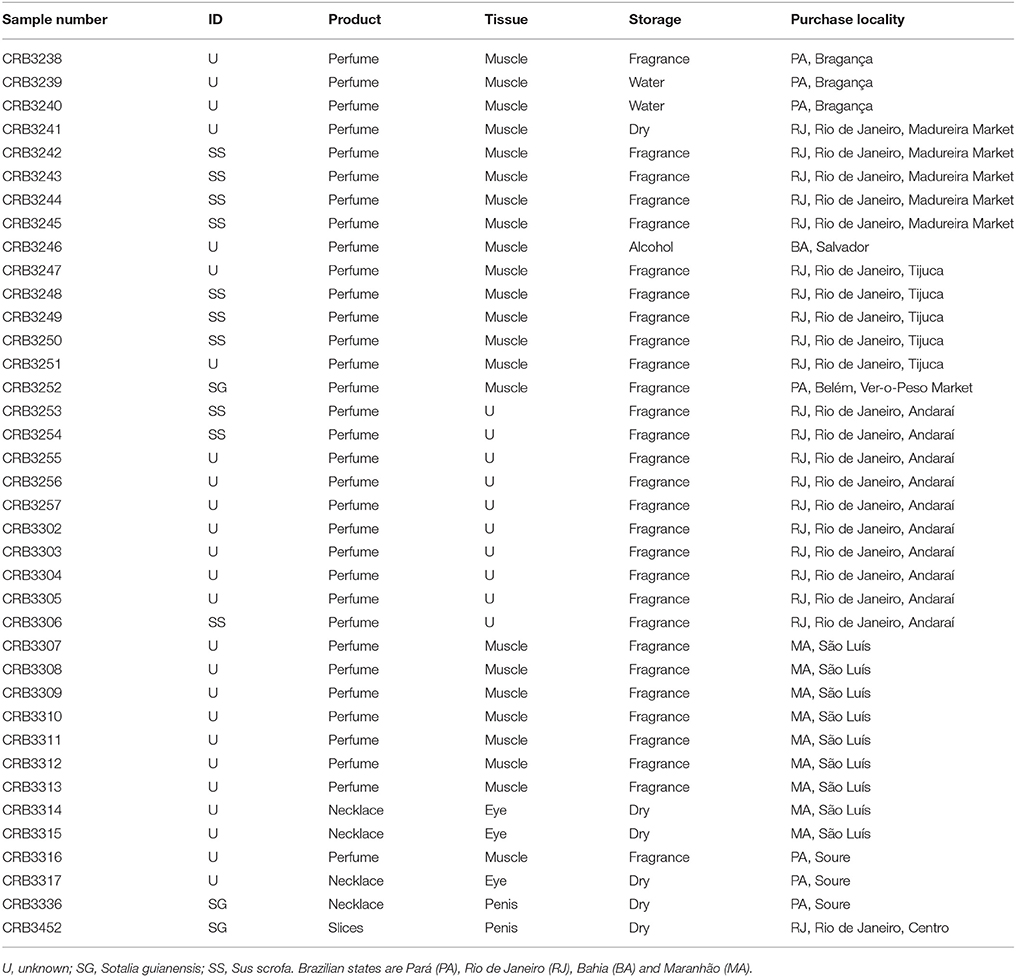
Table 1. Dolphin love charm samples, with sample number, identification (ID), type of product, tissue, storage, and purchase locality.
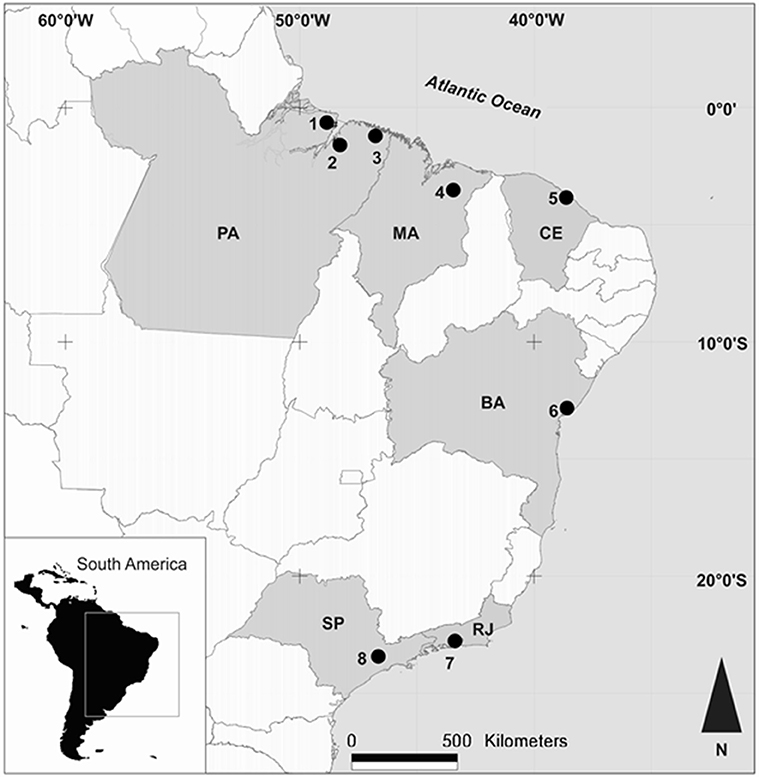
Figure 1. Map displaying the dolphins love charm sampling sites. (1) Soure, PA, (2) Belém, PA, (3) Bragança, PA, (4) São Luís, MA, (5) Fortaleza, CE, (6) Salvador, BA, (7) Rio de Janeiro, RJ, (8) Guarulhos and São Paulo, SP. For more information, see Supplementary Material.
A list of shops visited by city, their addresses and the articles purchased, along with their value in Brazilian currency, are provided in Supplementary Material 1. A total of 38 love charm samples were selected for species identification. Among perfumes, defined as fragrances with a piece of “dolphin” tissue inside the vial, the most common items were dehydrated eyes, penis (or dried penis portions) and vaginas (Table 1). Dehydrated penises are usually sold as a single piece, although one shop in Rio de Janeiro offered them in thin slices. Less common items found in Pará, Bahia and Rio de Janeiro included vials containing “dolphin” and “whale” oils and small, sun-dried, pieces of blubber and muscle labeled as “botos” (Figure 2). A very uncommon item was a newborn Guiana dolphin (S. guianensis) skull from the Ver-o-Peso market in Belém, Pará. Sequences of the mitochondrial gene Cytochrome b, referred to as MT-CYB, following HGNC rules (Eyre et al., 2006; HGNC, 2009) were analyzed for species identification.
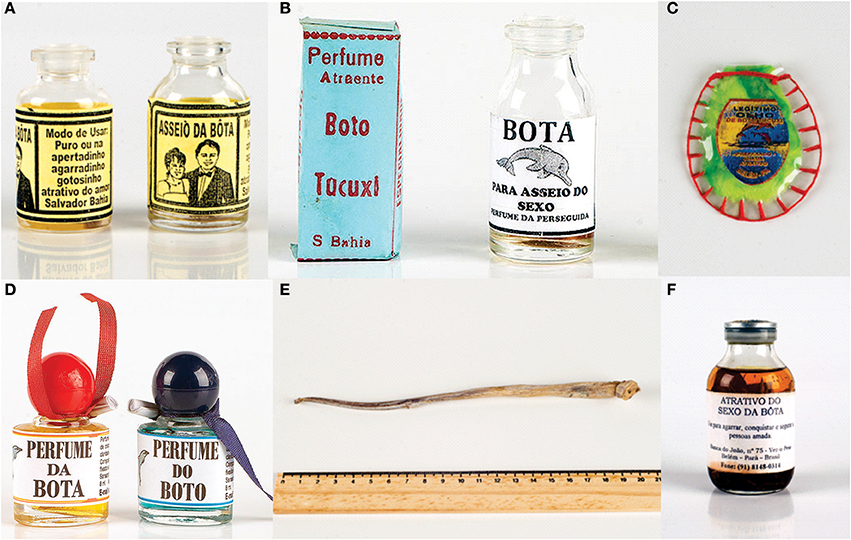
Figure 2. Love charm samples. (A) “Dolphin perfume charm” from São Luís, Maranhão state, (B) “Dolphin sex attractive” from Bragança, Pará state, (C) Eye dolphin from Bragança, Pará state; (D) “Dolphin perfume charm” from Tijuca, Rio de Janeiro, Rio de Janeiro state, (E) Dried penis from Mercadão de Madureira, Rio de Janeiro, Rio de Janeiro state, (F) “Dolphin sex attractive” from Ver-o-Peso Market, Belém, Pará state.
Thirty-eight DNA samples were isolated through the phenol-chloroform protocol (Sambrook et al., 1989). The complete MT-CYB (ca. 1,140 bp) was PCR-amplified with CB-out 1 and CB-out 2 primers [19], by a pre-denaturation step at 94°C for 2 min; 35 denaturation cycles at 94°C for 30 s, annealing at 54°C for 30 s, an extension step at 72°C for 90 s, and a final extension step at 72°C for 5 min. Amplicons were purified using the GFX PCR DNA and Gel Band Purification kits (GE Healthcare, Brazil). Sequencing reactions were performed with CB-out 1, CB-out 2, CB-in 1 and CB-in 2 (Cassens et al., 2000). Amplicons were labeled with the XL and BigDye® Terminator v3.1 Cycle Sequencing Kit (Applied Biosystems) and loaded on an ABI Prism™ 3130 platform.
Sequences were edited and assembled with ChromasPro (McCarthy, 1988) and Bioedit (Hall, 1999). Assembled sequences were compared to data from the Basic Local Alignment Search Tool (https://blast.ncbi.nlm.nih.gov/Blast.cgi to confirm identification. Subsequently, pre-identification related sequences from GenBank (https://www.ncbi.nlm.nih.gov/genbank/) were used for comparisons. Sequences were aligned using MEGA v.6 (Tamura et al., 2011) and the phylogenetic MT-CYB analyzes included the sequences herein obtained (GenBank accession numbers KY236017-KY236029) plus Sotalia guianensis (EF488216 to EF488223, EF457552), Sotalia fluviatilis (EF457551), Inia geoffrensis (EU554562), Tursiops truncatus (AF084095), and Sus scrofa (AB015065, AM492546, AM492548, AM492551, AM492569, AM492595, AM492597, AM92621, AM492653, KJ476220, KJ476229) sequences.
Genetic distance estimates were carried out with complete deletion using Kimura's two parameters with MEGA v.6. To infer phylogenetic relationships, the best evolution model was chosen using the ModelGenerator v. 0.85 (Keane et al., 2006). According to the Bayesian information criterion (BIC) and Akaike information criterion 2 (AIC2), the Tamura-Nei model with estimation of the proportion of invariable sites (TrN+I) was used. Phylogenetic reconstructions of the Sotalia guianensis MT-CYB sequences were performed using PHYML 3.0 (Guindon et al., 2010) for maximum likelihood (ML) with a bootstrap analysis based on 1,000 replicates. Branch support was calculated using the approximate likelihood ratio test (aLRT) with a SH-like interpretation. Bayesian analyzes (BA) were carried out using MrBayes 3.2.1 (Ronquist and Huelsenbeck, 2003) sampling every 100th generation until 10,000 trees were obtained (with a burn-in of 1,000). Effective sample size (ESS) and convergence diagnostic values were considered when above 100 and 1, respectively. Topologies were generated and edited with FigTree v1.4.0 (Rambaut, 2012). DNAsp 5 was used for haplotype estimates and nucleotide diversity (Librado and Rozas, 2009). NETWORK (Bandelt et al., 1999) was used for reconstructing a median-joining (MJ) network to evaluate sub-population structures and geographic distribution patterns. MJ was calculated using variable sites only.
A wide variety of love charms, sold in vials containing perfumes or fragrances were found in all markets and shops visited in the cities of Belém, Soure and Bragança in Pará, São Luís in Maranhão, Salvador, in Bahia; Rio de Janeiro, in Rio de Janeiro, and São Paulo and Guarulhos, in São Paulo (Supplementary Material 1, Figure 1). Data indicated a wide spectrum of vials and product textures and demonstrated that the commerce of cetacean products is more common in the North and Southeastern regions compared to the Northeast (Supplementary Material 1). Every religious shop visited in Rio de Janeiro and Belém displayed love charms available for purchase. Dried dolphin eyes, penis and vagina were only found in Belém, Soure and São Luís, in Maranhão, but also at the Mercadão de Madureira, in Rio de Janeiro (Figures 1, 2). Thirteen samples were identified by molecular phylogeny (Table 1), while other samples containing only liquid contents, liquid and plant material or very degraded animal contents, could not be amplified. The ML and BA analyzes clearly indicated that the samples belonged to two species: Guiana dolphins (Sotalia guianensis) (Figure 4) and Sus scrofa (Figure 5).
Successfully sequenced samples were compared to data from the online database. Three samples were identified as Sotalia guianensis (Figure 3). Genetic distances varied from 0.001 to 0.008 among S. guianensis specimens (Table 2). The DNAsp analysis indicated a diversity of 0.8897 and eight haplotypes, three exclusive and five shared by four or two individuals. The median joining network indicated a star-like topology, with the central haplotype shared by four samples, including three GenBank sequences, and one sample sequenced herein, with all other haplotypes, except H8, directly connected to the central haplotype (Figure 4A). The phylogenetic reconstruction of the Sotalia MT-CYB sequences demonstrated the monophyly of the genus (90 bootstrap, 0.97 pp), divided into the S. fluviatilis lineage and the clade comprising S. guianensis samples (Figure 4B).
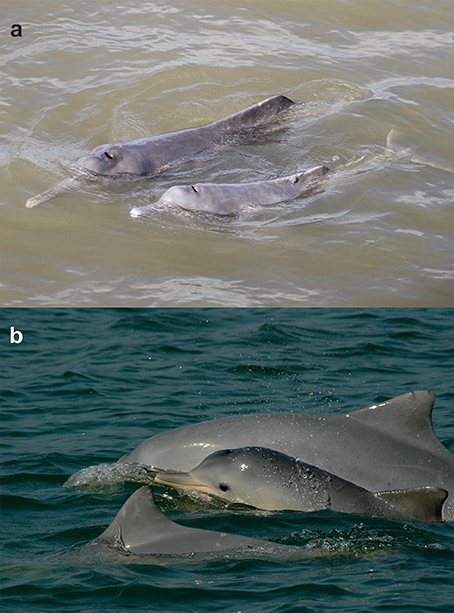
Figure 3. (A) Mother and calf boto (Inia spp.) sighted off Mocajuba, Tocantins River, Pará, Brazil; these may be “Araguaian botos,” Inia araguaiaensis which has been proposed as a new species' (Siciliano et al., 2016) and (B) a group of Guiana dolphins (Sotalia guianensis). Photos by PH Ott and MCO Santos, respectively.
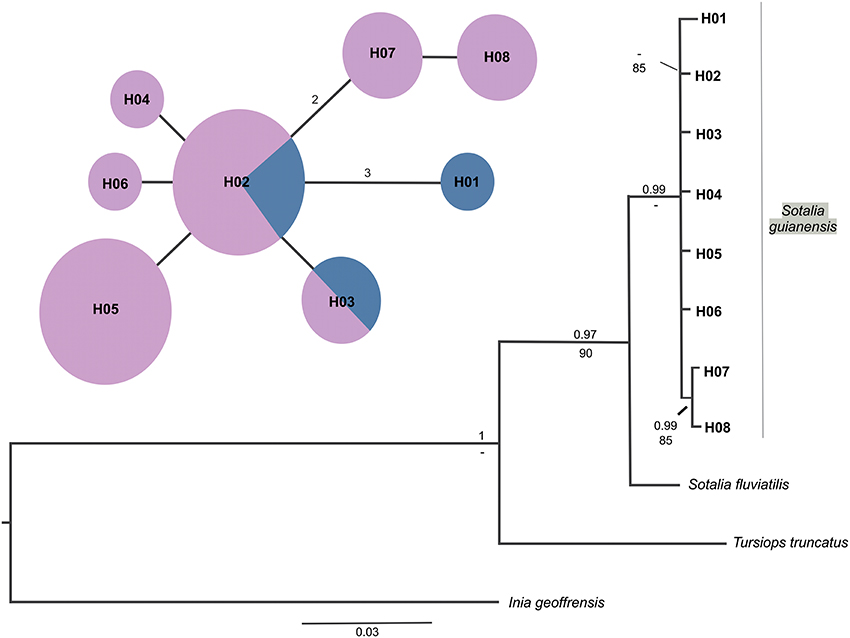
Figure 4. (A) MJ analysis of Sotalia guianensis carried out with variable sites. Values above branches indicate the number of mutations between two haplotypes. Branches without values showed only one mutation. Blue circles or slices, represents samples purchased in this work. Pink circles or slices, represents GB sequences. (B) Phylogenetic reconstruction of Sotalia guianensis carried out with TrN+I model, and Bayesian analysis (BA), maximum likelihood (ML) with bootstrap based on 1,000 replicates. Numbers above branches are posterior probabilities, and below are bootstrap values. Low value support (>70%) are not shown. Haplotypes are described in Table 2.
Surprisingly, ten samples were identified as originating from pigs' (Sus scrofa), with 100 and 95% cover and identity, respectively, identified through a BLAST search carried out at the NCBI database (Table 3). The genetic distance among Sus scrofa samples ranged from 0.001 to 0.016 (Table 3). The DNAsp analysis indicated a diversity of 0.8238 and 12 haplotypes, with only H1 and H9 being shared (Figure 5). H9 is shared by one sample evaluated in this study from Andaraí, Rio de Janeiro (Table 3) and one sample from Sri Lanka.
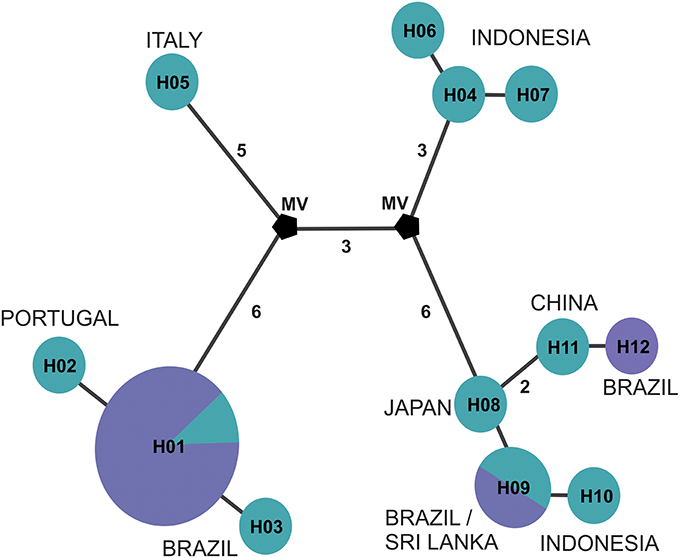
Figure 5. MJ analysis of Sus scrofa carried out with variable sites. Values next to branches indicate the number of mutations between two haplotypes. Branches without values, showed only one mutation. Purple circles or slices, represents samples purchased in this work. Green circles or slices, represents GB sequences. Haplotypes are described in Table 3.
Previous studies in Brazil have documented the use of Sotalia dolphin fat for therapeutic purposes in Northeastern Brazil, in the states of Piauí, Paraíba, and Maranhão, and suggested a geographic continuum in the use of cetaceans as medicine in fishing communities located on the northeastern coast (Alves and Rosa, 2006, 2007). Additional information has been provided on the use of Sotalia dolphins for medicinal and magic/religious purposes in Northern Brazil based on short surveys conducted at Belém and Soure in 2005 (Alves and Rosa, 2008). Alves and Rosa refer to the specimens as tucuxi dolphins (Sotalia fluviatilis), without any molecular analysis being conducted. However, subsequent studies based on Cytochrome b sequences, also conducted on samples from the Ver-o-Peso Market in Belém, proved that the love charms were Guiana dolphins (Sotalia guianensis) (Sholl et al., 2008). Sholl et al. postulated that S. guianensis specimens incidentally captured in gill nets off the Pará and Amapá coasts were the main source of the products found in regional markets. The present study confirms the current sale of cetacean products available in Belém and Soure as being Guiana dolphins, and adds Bragança to the list of cities where dolphin love charms are widely sold in the state of Pará (Figure 4, Table 2). The ML and BA analyzes were not well-resolved enough to define the geographic origin of the samples, since specimens from Rio de Janeiro and Pará can share the same haplotype (Sholl, 2010).
The sale of dolphin love charms was also confirmed in all other visited cities in the states of Maranhão (São Luís), Ceará (Fortaleza), Bahia (Salvador), Rio de Janeiro (Rio de Janeiro), and São Paulo (São Paulo and Guarulhos), indicating the widespread use of these products in Brazil. The love charms were much alike in all locations, presented as small vials containing perfumes or fragrances. In fact, these vials are very similar in appearance, which could represent specific dealers or similar sources. On the other hand, in Fortaleza, Ceará, necklaces and bracelets adorned with S. guianensis teeth were the only love charm product found in a public market. Adornments using Guiana dolphin teeth were also found at the traditional open-air market at Praça da República, in Belém. Because of this, handicraftsmen were sought out by the authors (SS and REL) and were found to be in possession of a large amount of Sotalia teeth on the ferryboat that cruises from Camará to Belém, Pará. The handicraftsmen reported they had purchased the teeth from various fishing villages during their trip to the Amazon. Additionally, some Guiana dolphin dried penis samples analyzed herein were purchased at the Mercadão de Madureira in Rio de Janeiro, but the retailer stated that this material came from Northern Brazil.
A remarkable aspect of the present study is the confirmation of the widespread use of dolphin love charms in the city of Rio de Janeiro, where every visited religious shop had samples available for sale. In fact, a popular newspaper in Rio de Janeiro has published on this issue, connecting increased love charm sales, especially from “dolphins,” to Valentine's Day in Brazil (June 12th) (Extra, 2013). Even more surprisingly was the fact that the products from Rio de Janeiro were fake and were identified as originating from pigs' (Sus scrofa) (Figure 5, Table 3). It is worth mentioning that Sus samples, like the dolphin love charms, are from different breeds, suggesting different origins of the alleged fake pieces inserted in the vials, as indicated in Figure 5. This can be explained by the fact that several Sus raised in Brazil belong to different breeds and origins, including Asian (Meishan, Jiaxing and Jinhua), Portuguese (Alentejana and Bísara), Spanish (Galega and Perijordina), and Italian (Napolitana) breeds, among others (Castro et al., 2002). This suggests that the trade of fake love charms is widespread in Rio de Janeiro, with more than one source of pig samples.
This scenario poses a clear contrast between products sold in northern Brazil, especially in Pará, and those from Rio de Janeiro. It seems that dolphin products in northern Brazil are still being used on a regular basis, with Guiana dolphin specimens incidentally captured in gill nets serving as the source for this market. As commonly observed along the beaches of northern Brazil, dolphin carcasses (Inia and Sotalia) can be found with their teeth, eyes or other parts removed. In order to evaluate the accidental capture of dolphins, 190 interviews were conducted with artisanal fishermen on the northeastern coast of Pará, and at Marajó island, highlighting the use of eyes and genitals for creating love charms (Martins, 2015). Dolphin and whale captures in Brazil are illegal. In contrast, dolphin love charms sold in the state of São Paulo did not include dolphin tissues, and all vendors informed that law enforcement has been applied and that this was a prohibited practice.
Even though the dolphin love charm trade in São Paulo is limited to fragrances, with no pieces of dolphins or other products added, in Rio de Janeiro the items were false, produced by adding pig tissues, to increase sales and profit. Nevertheless, it seems clear that the dolphin eye, penis and vagina trade is still present, mainly in Northern Brazil. The data presented herein confirms the regular trade of dolphin products, representing an active market in large North and Northeastern cities. Although it is clear that the majority of dolphin samples came from incidentally caught specimens, it is important to note that a small fraction could be represented by botos, not covered in our samples. In addition, Guiana dolphins caught in gill nets represent almost 90% of the 700 specimens deposited at the marine mammal collection at the Emílio Goeldi Paraense Museum, while botos represent less than 3%. This could be due to the fact that Guiana dolphins are widely distributed, and probably more abundant, than botos. As a common source of love charms, the apparent high levels of incidental Guiana dolphin captures clearly stimulates the love charm trade, and, thus, requires urgent action from environmental agencies.
Conceived and designed the experiments: SS, RE-L, MV, CB. Performed the experiments: MV, CB. Analyzed the data: SS, MV, CB. Contributed reagents, materials, analysis tools: SS, RE-L, MV, CB. Wrote the paper: SS, RE-L, MV, CB. Performed the molecular identification of the dolphins: SS, MV, CB. Provided data and comprehensive interpretation of the results: SS, RE-L, MV, CB.
This study was funded by Conselho Nacional de Desenvolvimento Científico e Tecnológico (CNPq) grants to CB (473687/2013-5 and 304498/2014-9), Fundação de Amparo à Pesquisa do Estado do Rio de Janeiro (FAPERJ) to CB (E-26/201-200/2014), and VALE/FAPESP/FAPESPA/FAPEMIG to RE-L (no. 038/2011).
The authors declare that the research was conducted in the absence of any commercial or financial relationships that could be construed as a potential conflict of interest.
The authors are indebted to Zafira da Silva de Almeida, Nathali G. Ristau, and Andrea A. Cutrim from the Universidade Estadual do Maranhão for providing logistical support and additional information during visits to markets and shops in São Luís. Aline Guedes kindly provided samples from Salvador. Ivan S. Najan kindly revised an early version of the manuscript. Héctor Seuánez kindly revised the draft.
The Supplementary Material for this article can be found online at: https://www.frontiersin.org/articles/10.3389/fmars.2018.00107/full#supplementary-material
Alves, R. R. N., and Rosa, I. L. (2006). From cnidarians to mammals: the use of animals as remedies in fishing communities in NE Brazil. J. Ethnopharm. 107, 259–276. doi: 10.1016/j.jep.2006.03.007
Alves, R. R. N., and Rosa, I. L. (2007). Zootherapeutic practices among fishing communities in North and Northeast Brazil: a comparison. J. Ethnopharm. 111, 83–103. doi: 10.1016/j.jep.2006.10.033
Alves, R. R. N., and Rosa, I. L. (2008). Use of tucuxi dolphin Sotalia fluviatilis for medicinal and magic/religious purposes in north of Brazil. Hum. Ecol. 36, 443–447 doi: 10.1007/s10745-008-9174-5
Bandelt, H. J., Forster, P., and Röhl, A. (1999). Median-joining networks for inferring intraspecific phylogenies. Mol. Biol. Evol. 16, 37–48. doi: 10.1093/oxfordjournals.molbev.a026036
Best, R. C., and da Silva, V. M. F. (1989). “Biology, status and conservation of Inia geoffrensis in the Amazon and Orinoco basin,” in Biology and Conservation of the River Dolphins, eds W. F. Perrin, R. L. Brownell, Z. Kaiya, and L. Jiankang (Gland: International Union for Conservation of Nature and Natural Resources- IUCN), 23–34.
Campos, M., Maciel, M. L., Cotta, M. A., and Anjos, R. (2013). Contando as Histórias Que nos Contaram: Lendas, Mitos e Contos de Assombração. Belém: Editora Paka-Tatu.
Cassens, I., Vicario, S., Waddell, V. G., Balchowsky, H., Van Belle, D., Ding, W., et al. (2000). Independent adaptation to riverine habitats allowed survival of ancient cetacean lineages. Proc. Nat. Acad. Sci. U.S.A. 97, 11343–11347. doi: 10.1073/pnas.97.21.11343
Castro, S. T. R., Albuquerque, M. S. M., and Germano, J. L. (2002). Census of Brazilian naturalized swine breeds. Arch. Zootec. 52, 235–239. Available online at: http://citeseerx.ist.psu.edu/viewdoc/download?doi=10.1.1.880.8934&rep=rep1&type=pdf
Chiarello, A. G., Aguiar, L. M. S., Cerqueira, R., Melo, F. R., Rodrigues, F. H. G., and da Silva, V. M. F. (2008). “Mamíferos ameaçados de extinção no Brasil,” in Livro Vermelho da Fauna Brasileira Ameaçada de Extinção, eds A. B. M. Machado, G. M. Drummond, and A. P. Paglia (Brasília: MMA; Belo Horizonte: Fundação Biodiversitas), 1420.
Cravalho, M. A. (1999). Shameless creatures: an ethnozoology of the Amazon river. Dolphin. Ethnology 38, 47–58. doi: 10.2307/3774086
Extra, A. (2013). Lojas de Artigos Religiosos Dobram a Venda de Perfume Como Pega Homem e Pega Mulher no Mês dos Namorados Extra. Rio de Janeiro. Available online at http://extra.globo.com/noticias/rio/zona-oeste/lojas-de-artigos-religiosos-dobram-venda-de-perfume-como-pega-homem-pega-mulher-no-mes-dos-namorados-8626888.html
Eyre, T. A., Ducluzeau, F., Sneddon, T. P., Povey, S., Bruford, E. A., and Lush, M. J. (2006). The HUGO gene nomenclature database, 2006 updates. Nucleic Acids Res. 34, D319–D321. doi: 10.1093/nar/gkj147
Gravena, W., Hrbek, T., da Silva, V. M. F., and Farias, I. P. (2008). Amazon river dolphin love fetishes: from folklore to molecular forensics. Mar. Mam. Sc. 24, 969–978. doi: 10.1111/j.1748-7692.2008.00237.x
Guindon, S., Dufayard, J.-F., Lefort, V., Anisimova, M., Hordijk, W., and Gascuel, O. (2010). New algorithms and methods to estimate maximum-likelihood phylogenies: assessing the performance of PhyML 3.0. Syst. Biol. 59, 307–321. doi: 10.1093/sysbio/syq010
Hall, T. A. (1999). BioEdit: a user-friendly biological sequence alignment editor and analysis program for Windows 95/98/NT. Nucleic Acids Symp. Ser. 41, 95–98.
HGNC (2009). HGNC Database, HUGO Gene Nomenclature Committee (HGNC). Hinxton: EMBL Outstation, Wellcome Trust Genome Campus, European Bioinformatics Institute.
Keane, T. M., Creevey, C. J., Pentony, M. M., Naughton, T. J., and McLnerney, J. O. (2006). Assessment of methods for amino acid matrix selection and their use on empirical data shows that ad hoc assumptions for choice of matrix are not justified. BMC Evol. Biol. 6:29. doi: 10.1186/1471-2148-6-29
Librado, P., and Rozas, J. (2009). DnaSP v5: a software for comprehensive analysis of DNA polymorphism data. Bioinformatics 25, 1451–1452 doi: 10.1093/bioinformatics/btp187
Lopes, X. M., Silva, E., Bassoi, M., Santos, R. A., and Santos, M. C. O. (2012). Feeding habits of Guiana dolphins, Sotalia guianensis, from south-eastern Brazil: new items and a knowledge review. J. Mar. Biol. Assoc. 92, 1723–1733. doi: 10.1017/S0025315412000495
Martins, B. M. L. (2015). A Pesca e os Botos: Percepção dos Pescadores e Análise das Capturas Acidentais de Pequenos Cetáceos no Estuário Amazônico. Dissertation/Master's Thesis. Ilhéus: Universidade Estadual de Santa Cruz. Available online at: https://docs.wixstatic.com/ugd/5964a0_9ea74e2555d3421294ff7874d07ddc19.pdf
McCarthy, C. (1988). Chromas, Version 1.45 (32-bit). Nathan, QLD: School of Health Science, Griffith University.
Monteiro, W. (2002). Viagens, Assombrações e Encantamentos da Amazônia. No. 07. Belém: Gráfica Smith.
Rambaut, A. (2012). FigTree v1.4. Available online at http://tree.bio.ed.ac.uk/software/figtree
Ronquist, F., and Huelsenbeck, J. P. (2003). MrBAYES 3: Bayesian phylogenetic inference under mixed models. Bioinformatics 19, 1572–1574. doi: 10.1093/bioinformatics/btg180
Sambrook, J., Fritsch, E. F., and Maniatis, T. (1989). Molecular Cloning: A Laboratory Manual. Cold Spring Harbor, NY: Cold Spring Harbor Laboratory Press.
Santos, E. (1987). História, Lendas e Folclore de Nossos Bichos. Belo Horizonte: Editora Itatiaia Limitada.
Sholl, T. (2010). Estudo Ecotoxicológico e Evolutivo em Populações do Boto-Cinza Sotalia guianensis (Van Bénéden, 1875) na Costa Brasileira. Dissertation/Master's Thesis, Escola Nacional de Saúde Pública, Rio de Janeiro. Available online at: https://www.arca.fiocruz.br/handle/icict/2478
Sholl, T. G. C., Nascimento, F. F., Leoncini, O., Bonvicino, C. R., and Siciliano, S. (2008). Taxonomic identification of dolphin love charms commercialized in the Amazonian region through the analysis of cytochrome b DNA. J. Mar. Biol. Assoc. 88, 1207–1210. doi: 10.1017/S002531540800043X
Siciliano, S. (1994). “Review of small cetaceans and fishery interactions in coastal waters of Brazil,” in Report International Whaling Commission, Special Issue, Gillnets and Cetaceans, eds W. F. Perrin, G. P. Donovan, and J. Barlow (Cambridge: International Whaling Commission), 241–250.
Siciliano, S., Valiati, V. H., Emin-Lima, R., Costa, A. F., Sartor, J., Dorneles, T., et al. (2016). New genetic data extend the range of river dolphins Inia in the Amazon delta. Hydrobiology 2016, 1–15. doi: 10.1007/s10750-016-2794-7
Simões, M. S., and Golder, C. (1995a). Santarém Conta Narrativas, Recriações, Depoimentos: O Imaginário nas Formas Narrativas Orais Populares da Amazônia Paraense. Belém: Editora Universidade Federal do Pará.
Simões, M. S., and Golder, C. (1995b). Belém Conta Narrativas, Recriações, Depoimentos: O Imaginário nas Formas Narrativas Orais Populares da Amazônia Paraense. Belém: Editora Universidade Federal do Pará.
Simões, M. S., and Golder, C. (1995c). Abaetetuba Conta Narrativas, Recriações, Depoimentos: O Imaginário nas Formas Narrativas Orais Populares da Amazônia Paraense. Belém: Editora Universidade Federal do Pará.
Slater, C. (2001). A Festa do Boto: Transformação e desencanto na imaginação amazônica. Rio de Janeiro: Editora FUNARTE.
Souza, M. (1982). A Irresistível Ascensão do Boto Tucuxi: Folhetim. Rio de Janeiro: Editora Marco Zero.
Keywords: love charms, Sotalia, trade, Cytochrome b, phylogeny, Amazon
Citation: Siciliano S, Viana MC, Emin-Lima R and Bonvicino CR (2018) Dolphins, Love and Enchantment: Tracing the Use of Cetacean Products in Brazil. Front. Mar. Sci. 5:107. doi: 10.3389/fmars.2018.00107
Received: 19 October 2017; Accepted: 14 March 2018;
Published: 09 April 2018.
Edited by:
Fernando Tuya, University of Las Palmas de Gran Canaria, SpainReviewed by:
Mark Peter Simmonds, University of Bristol, United KingdomCopyright © 2018 Siciliano, Viana, Emin-Lima and Bonvicino. This is an open-access article distributed under the terms of the Creative Commons Attribution License (CC BY). The use, distribution or reproduction in other forums is permitted, provided the original author(s) and the copyright owner are credited and that the original publication in this journal is cited, in accordance with accepted academic practice. No use, distribution or reproduction is permitted which does not comply with these terms.
*Correspondence: Salvatore Siciliano, Z2VtbWxhZ29zQGdtYWlsLmNvbQ==
Disclaimer: All claims expressed in this article are solely those of the authors and do not necessarily represent those of their affiliated organizations, or those of the publisher, the editors and the reviewers. Any product that may be evaluated in this article or claim that may be made by its manufacturer is not guaranteed or endorsed by the publisher.
Research integrity at Frontiers

Learn more about the work of our research integrity team to safeguard the quality of each article we publish.